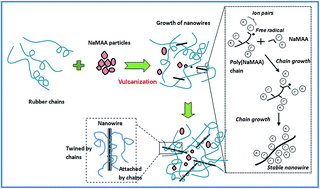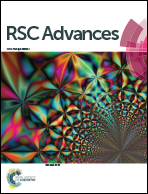Improved mechanical properties and thermal degradation of low-temperature hydrogenated acrylonitrile butadiene rubber composites with poly(sodium methacrylate) nanowires†
Abstract
One dimensional (1D) organic nanofiller hybrid composites have captured scientists’ attention due to their importance in property reinforcement. However, the generation and good dispersion of these nanostructures is always difficult to solve in such composites. In this article, low-temperature grade hydrogenated acrylonitrile butadiene rubber (LTG-HNBR) composites with various sodium methacrylate (NaMAA) weights were prepared. By the induction of electrostatic interactions and in-site polymerization, 1D poly(NaMAA) nanowires were created in the matrix during their vulcanization processes. Owing to the existence of nanowires, the modulus and tensile properties of the composites were greatly reinforced, but their glassy temperatures barely changed. Thermogravimetric analysis (TGA) shows that the incorporation of NaMAA increased the thermal decomposition temperature of the matrix, and the advent of poly(NaMAA) nanowires helped enhance the thermal stability of the composites, reducing the diffusion speed of degradation products and thus improving the decomposition temperatures. We believe that these findings can provide some guidance to direct the applications of rubber composites with organic 1D nanowires.



 Please wait while we load your content...
Please wait while we load your content...